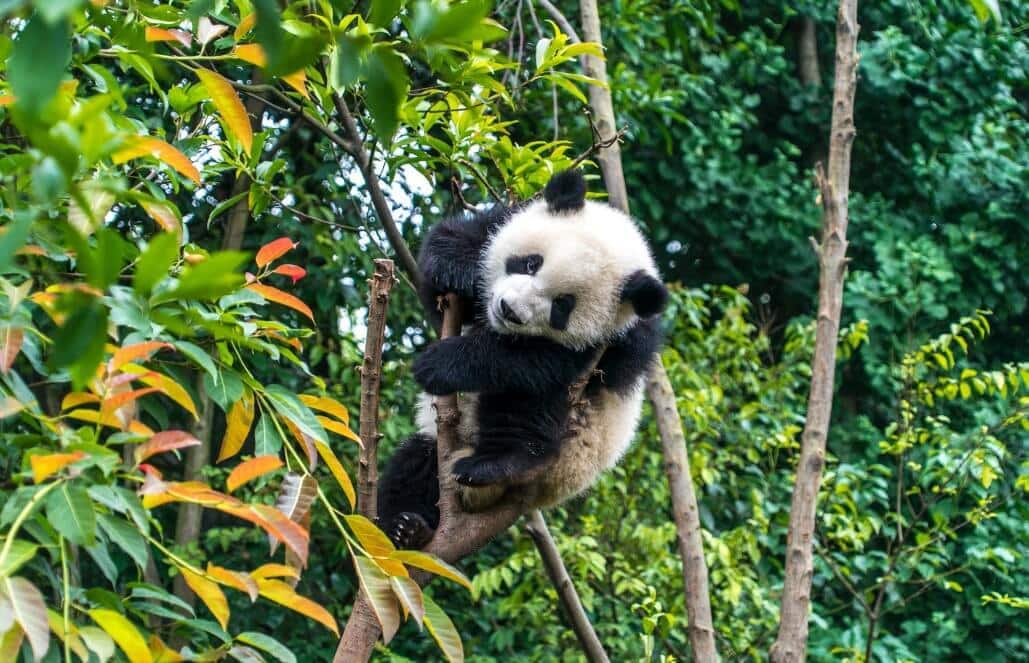What is that beautiful animal hanging out in the Chinese forests? Why, the amazing giant panda, of course! Easily recognizable by their mix of black and white fur, these gentle giants have become quite the iconic species.
Let me officially introduce to you the giant panda.

- “Giant panda” is actually just a nickname for a panda; they are no specifically larger than others.
- Pandas eat consistently for 12-14 hours a day!
- Adult panda bears can weigh as much as 45 kilos (100 pounds).
- Like other bears, pandas can swim! They do not, however, hibernate, as they are unable to store energy over long periods of time (hence their 12-hour eating routine).
- Pandas, although native to China, are one of the few indigenous wildlife species that were never hunted for use in traditional Chinese medicine.

- Newborn pandas are pink!
- Although pandas eat mostly bamboo and fruit, their teeth are carnivorous, meaning they would be able to chew and consume tough meat.
- Panda fossils have confirmed their extinct from one to two million years ago!
- Panda cubs can be as small as a stick of butter- they are approximately 1/900th the size of their mother at birth.
- Panda cubs can climb trees at just the young age of six months!
Are giant pandas endangered?
Pandas are the face of the wildlife conservation organization, the World Wildlife Fund, but are they endangered?
In 1984, giant pandas were labeled as endangered, and faced a serious threat of extinction. Thanks to rigorous conservation efforts, however, they are no longer labeled as “endangered” by the International Union for Conservation of Nature, but they are still labeled as a “vulnerable” species. In 2014, less than 2,000 giant pandas were accounted for.
Habitat loss is the number one threat to the giant panda population. According to the World Wildlife Fund, the panda’s habitat has been destroyed due to being logged for timber and fuel wood, or cleared for agriculture and infrastructure to meet the needs of the area’s booming population.China banned logging in these areas in 1998, but forest fragmentation has taken over as a threat. The building of roads and railways divides panda populations, and poses a threat to breeding and therefore the sustainability of the population. This isolation also makes it difficult for pandas to have easy access to bamboo.
Their habitats are further threatened by those who are searching for plants that are present in panda habitats, such as the Minshan Mountains. Around 75% of the plants in this area of panda habitat are used in traditional Chinese medicine.
Here are a few tips on how you can help the panda on your trip in China:
Don’t travel into panda habitats. There are plenty of mountainous areas in China, and bustling cities to explore – try to avoid going off-course and into areas where pandas like to dwell. Partake in ecotourism excursions during your travels in China.
Donate to a conservation program. There over 60 different conservation programs and sanctuaries in China that are focused on conserving the giant panda, but they need your help! If you have some cash left over from your eco travels, consider making a donation to help the organizations that are working hard every day to ensure the panda’s survival. These organizations may be sanctuaries that take in injured pandas or centers that breed pandas.
Volunteer at a panda sanctuary. To provide hands-on assistance in conserving the giant panda, sign up to volunteer at a giant panda sanctuary! There are many options, and they may include breeding programs. GoEco’s Giant Panda Center panda population has risen from an initial 6 animals to over 70 pandas. In 2003 the first stage of a state-of-the-art panda base was completed: a veritable panda paradise. It is divided into 6 sections: panda raising and breeding area, scientific study area, food preparation and animal hospital area, staff living area, bamboo base area and tourist accommodation area.
But first, how do you spot a good panda sanctuary?
Ask what the sanctuary goals are. To fully understand the purpose of an individual sanctuary, question what the sanctuary’s goals are. Some sanctuaries may be providing care for injured animals, while some may focus on caring for pandas as a part of a breeding program. Other sanctuaries may provide pandas with care, while educating visitors about the importance of their conservation.
Enclosure size. Check that the pandas are allowed to roam around, and are not confined to a cage 24/7. Some sanctuaries may put them inside during the nights, but be wary of “sanctuaries” that have no outdoor area for free roaming.
Enclosures are clean. If the sanctuary has enclosures, whether for feeding or sleeping purposes, take a look around to ensure that these areas are being properly maintained. Many sanctuaries that accept volunteers will require volunteers to assist heavily in the cleaning of these areas, and that is a good thing.
The pandas are being cared for properly. If volunteers are not allowed to feed the pandas, check if they have a steady supply of bamboo in their outdoor enclosure.
What’s your experience with pandas? Click here to take it off your bucket list.












